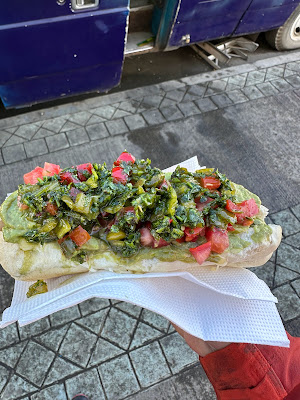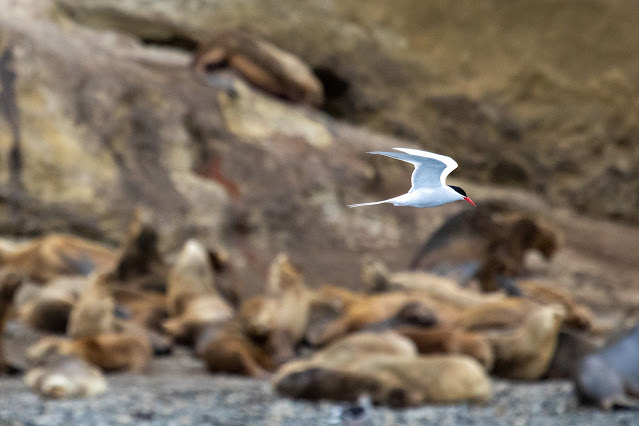We had time after our bus ride from Torres del Paine back to Puerto Natales to wander down to the water front and photograph some of the birds. This was the first town we stayed in on the coast which meant opportunity to see more new species of wildlife. It quickly became obvious that we timed our trip perfectly to see freshly hatched chicks and ducklings.
Black-necked Swans
Megellanic Oystercatchers
Chilean Widgeons
The irridescent eye bar was fun to catch light off of.
Crested Duck. Another species with a bright red eye.
Our itinerary after Torres del Paine was a little more flexible than the first two weeks of the trip. We did have a few things solidified on the calendar, a bus ride to Punta Arenas, a boat ride to see Megallanic Penguins, and plane tickets from Punta Arenas to Puerto Montt in the Lake Disitrict. We had penciled several options to explore from Puerto Montt, but hadn't committed to any itinerary, opting to wait and see where the weather and our motivations are when we got there.
The bus to Punta Arenasa was actually pretty uneventful. We caught the highway inland and the landscape was more heavily grazed than other areas, so wildlife were just not as common. Punta Arenas is by far the largest town/city we stopped in since leaving Buenas Aires. We really only had one goal for this part of the trip, and that was to see penguins. Our reservations for a half day boat ride to Isla Megdalena to see a large colony of Megallanic Penguins left the next morning, then we would play the afternoon by ear and catch our flight the following day.
After our long bus ride we mostly just wandered the city during our first evening, found some street food and then ultimately dinner. We were starting to see salmon showing up on the menus more. Salmon were introduced to Chile several decades ago. They are actually the same genetic lineage of Salmon from the Pacific Northwest. It gives me mixed feelings, on one hand they aren't supposed to be here and are absolutely out competing Chilean fish species or directly affecting the native ecosystem. On the other hand they are flourishing and the gene pool is still producing giant 40+ pound salmon. Those big fish genes were fished out of the Pacific Northwest in the last decades.
This hotdog was honestly one of the best things I had all trip.
The next morning we walked into town and our rendezvous location for our penguin visit. On the way out of town I spotted several whale spouts from the bus! That Strait of Magellan seperating Punta Arenas and Chile from Tierra del Fuego and Argentina must be a bottle neck for all sorts of marine animals. We would also get a close look at a Sei Whale right from the boat on the way to Island Magdalena.
Before we even beached on Isla Magdalena we could see penguins swimming and hunting off it's shores. I had never seen penguins outside of a zoo, so was completely enamored watching them porpoise and swim around us. Once we hit the beach and unloaded we were surrounded. There are around 60,000 pairs of Megallanic Penguins nesting on the island as well as gulls and other birds. I probably took 100 gigabytes worth of photos on the island. I just couldn't help myself.







We only had about 90 minutes on the island. Penguins were everywhere! They'd cross in front of you on their way to the water. Cut the line to go back up the hill to their nests. The hardest job in Chile is probably our boat guide's as he politely tried to keep us to our 90 minutes. As we got higher up the island, we started seeing chicks sticking their heads out from their nest cavity, and then some already big enough to be out enjoying the occasional sun. They're extremely cute with their neck rolls, triangular shape, and velvty looking down. I'd take one home if I could.
There were several thousand Kelp Gulls also nesting on the island, many had chicks of their own.
This one just made me laugh.
We saw a few other species of birds on the island too, skua, cormorants and more. Would have loved to spend a full day there and explore the whole thing.
Our boat would detour us around Isla Marta. We weren't allowed to get off on this island, but it was covered in South American Sea Lions. Our boat maneuvered in the swells allowing us to watch the sea lions and sea birds. The bull sea lions were MASSIVE. Imperial Cormorants claimed the top of the island for their nesting colony.

We watched South American Terns dive as we tried and failed to get a picture of one mid-dive. They're just too fast. I really like terns. They get a bad rap in WA since they eat the same fish we do. But they are just perfect little aerial dive bombers.
Giant Petrel
Imperial Cormorant
We arrived back in Punta Arenas around lunch, grabbed some food, and Austin and I decided we would stay in full wildlife viewing mode. We had been frustrated by our bus rides. They were super comfortable, affordable, and allowed us to see a lot of country. But we couldn't stop for roadside wildlife. We would spend the last afternoon in Punta Arenas trying to make up for that.
We walked downtown to a row of rental car companies. Punta Arenas is a major stop for tourist ships including those on their way to Antartica. One had just pulled in and the first couple of rental car companies we tried were sold out from people exploring off ship. We eventually found an Avis with an extremely nice staffer that agreed to rent us a car for the remainder of the day. He even allowed us to hang on to it after they closed and meet us back at the office at 9pm so we could take full advantage of the long daylight. With our economy car set to go we had two primary objectives, find Guanacos and Rheas!
It didn't take long. We drove north and 20 minutes outside of Punta Arenas we were finally able to stop and watch some Guanacos. The first thing we noticed was they are much bigger up close! Just such cool animals, perfectly built for this environment. And keeping with the trend, we found a group with some young chulengos as well.
It wasn't more than a few minutes later and we started to spot Rheas. These are Darwin's Rheas and having never seen any sort of large flightless bird like this in the wild, I thought they were just the coolest thing on two legs. We encounterd a couple solitary animals and then a female with chicks. She wouldn't stick around long and the whole family flock sprinted through the brush like a scene from Jurrasic Park.






Checked off the two main boxes we had to justify the rental car and still several hours before we needed to return it. We pulled out the map and found a section of forest that looked like our last longshot chance to see a Huemel for the trip. I've never tried to so hard to see a freaking deer. If all else fails we would see new parts of this beautiful country and maybe areas off of the typical tourist spots. It was indeed a different sort of environment. The beech forests closed in again and it felt very temperate, interesting since we were just barely north of antartic weather.
After driving around for a while and spotting a few birds, but nothing to jump out of the car for, we found our way into some signed conservation areas for the Ruddy-headed Goose. As we would learn these birds are quite common on the Falklands but there are only a few hundred left in Chile and Argentina due to overhunting and more recenly habitat loss. These wet, boggy, beech forests were apparently being conserved for nesting habitat.
It wasn't much further before we had to start thinking about returning the car and just admit Huemel defeat. I flipped the car around on our dirt road and headed back. While driving back through the goose nesting conservation areas I stopped to take a quick look at some geese that looked different to my eye. After second and third guessing myself, I finally accepted that we had found some endangered Ruddy-headed Geese! Look at these beautiful birds.
We also saw some Ashy-headed Geese. Another new species for the trip.
Go looking for a rare deer and find an exciting rare goose. We felt extremely fortunate as we watched them forage along their stream.
Rental car returned we repacked everything in prep for our flight north. We would be leaving the sub-antartic climate and Patagonia steppe for temperate rainforests and stratovolcanos, Patagonia's version of the Pacific Northwest.










































No comments:
Post a Comment